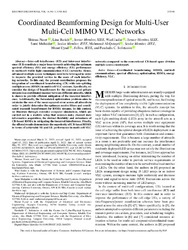Coordinated beamforming design for multi-user multi-cell MIMO VLC networks
| dc.contributor.author | Naser, S. | |
| dc.contributor.author | Bariah, L. | |
| dc.contributor.author | Jaafar, W. | |
| dc.contributor.author | Muhaidat, S. | |
| dc.contributor.author | Al-Qutayri, M. | |
| dc.contributor.author | Uysal, Murat | |
| dc.contributor.author | Sofotasios, P. C. | |
| dc.date.accessioned | 2023-06-25T20:00:04Z | |
| dc.date.available | 2023-06-25T20:00:04Z | |
| dc.date.issued | 2022-06 | |
| dc.identifier.issn | 1943-0655 | en_US |
| dc.identifier.uri | http://hdl.handle.net/10679/8470 | |
| dc.identifier.uri | https://ieeexplore.ieee.org/document/9761731 | |
| dc.description.abstract | Inter-cell interference (ICI) and inter-user interference (IUI) constitute a major issue towards achieving the optimum spectral efficiency (SE) and energy efficiency (EE) performance in multi-cell visible light communication (VLC) networks. Hence, advanced multiple access techniques need to be leveraged in order to improve the provided service to the users of such interfering networks. To this end, the present contribution proposes the integration of coordinated beamforming (CB) with rate-splitting multiple access (RSMA) in multi-cell VLC systems. Specifically, we consider the design of beamformers for the common and private streams in a coordinated manner between different attocells, which is shown to provide efficient mitigation of the incurred interference. Additionally, the formulated optimization problem aims to minimize the sum of the mean squared error across all attocells in order to jointly determine the optimum receive filters and coordinated transmit beamformers for RSMA streams. In this context, we illustrate through extensive computer simulations, which are carried out in a realistic setup that assumes noisy channel state information acquisition, the distinct flexibility and robustness of CB-based RSMA in mitigating the incurred interference. Finally, the offered results demonstrate the superiority of CB-based RSMA in terms of achievable SE and EE performance in multi-cell VLC networks compared to the conventional CB-based space division multiple access counterpart. | en_US |
| dc.language.iso | eng | en_US |
| dc.publisher | IEEE | en_US |
| dc.relation.ispartof | IEEE Photonics Journal | |
| dc.rights | Attribution 4.0 International | * |
| dc.rights | openAccess | |
| dc.rights.uri | http://creativecommons.org/licenses/by/4.0/ | * |
| dc.title | Coordinated beamforming design for multi-user multi-cell MIMO VLC networks | en_US |
| dc.type | Article | en_US |
| dc.description.version | Publisher version | en_US |
| dc.peerreviewed | yes | en_US |
| dc.publicationstatus | Published | en_US |
| dc.contributor.department | Özyeğin University | |
| dc.contributor.authorID | (ORCID 0000-0001-5945-0813 & YÖK ID 124615) Uysal, Murat | |
| dc.contributor.ozuauthor | Uysal, Murat | |
| dc.identifier.volume | 14 | en_US |
| dc.identifier.issue | 3 | en_US |
| dc.identifier.wos | WOS:000798340100001 | |
| dc.identifier.doi | 10.1109/JPHOT.2022.3169233 | en_US |
| dc.subject.keywords | Coordinated beamforming | en_US |
| dc.subject.keywords | Energy efficiency | en_US |
| dc.subject.keywords | MIMO | en_US |
| dc.subject.keywords | Multicell communications | en_US |
| dc.subject.keywords | Optimization | en_US |
| dc.subject.keywords | RSMA | en_US |
| dc.subject.keywords | Spectral efficiency | en_US |
| dc.subject.keywords | VLC | en_US |
| dc.identifier.scopus | SCOPUS:2-s2.0-85129153768 | |
| dc.relation.publicationcategory | Article - International Refereed Journal - Institutional Academic Staff |
Files in this item
This item appears in the following Collection(s)
Share this page




